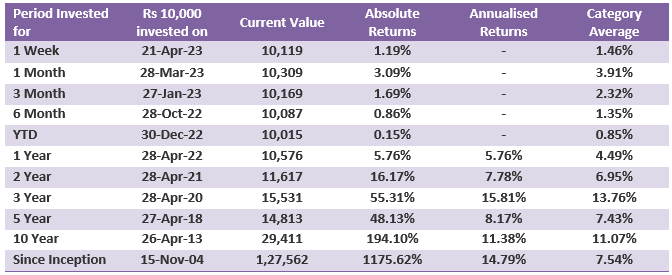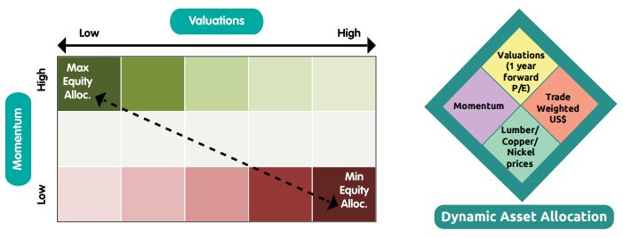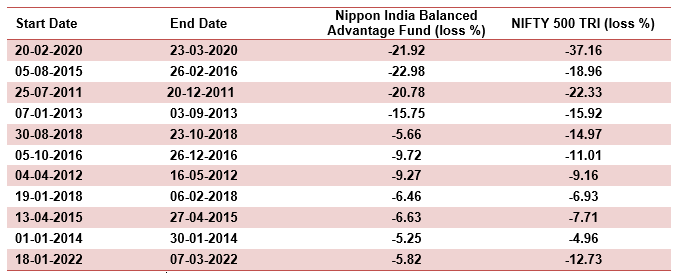Nippon India Balanced Advantage Funds: A good hybrid fund in the current market conditions

What are Balanced Advantage Funds?
Balanced Advantage Funds, also known as Dynamic Asset Allocation Funds, are hybrid mutual funds which manage their asset allocation dynamically between equity and debt. The asset allocation will change depending on market conditions using quantitative asset allocation models.
To know more, read this what are Balanced Advantage Funds?
How Balanced Advantage Funds work
We will conclude this blog post with our financial planning check-list for FY 2023-24:-
- Equity: This is the un-hedged equity exposure of the fund. Net equity allocation is determined by a quantitative dynamic asset allocation model based on market conditions.
- Fixed Income: Fixed income allocation is determined by the asset allocation model but is usually capped at 35% to ensure equity taxation.
- Hedging: This is the fully hedged equity component which is not exposed to market risks. Hedging reduces the net equity exposure and at the same time, helps to keep the gross equity exposure above 65%, which enables equity taxation.
Benefits of Balanced Advantage Fund
- Behavioral biases affect investor returns. Instead of “buying low and selling high” investors usually buy when market is high, thinking it will go higher. Similarly, investors sell when the market is low, thinking it will fall even lower.
- Balanced advantage funds have an analytical investment approach using quantitative asset allocation model. Dynamic asset allocation models increase equity allocation / decrease debt allocation when valuations are low and decrease equity allocation / increase debt allocation when valuations are high.
- Balanced advantage funds can implement “buy low, sell high” because they strictly follow model based investing without any human biases.
- Balanced advantage funds usually have low equity allocations at market peaks and therefore, have relatively lower downside risks in market corrections. These funds can provide stability to your portfolio in volatile markets.
- Since balanced advantage funds increase equity to their asset allocation at low valuations, they have the potential of delivering risk adjusted returns over sufficiently long investment tenures.
- Balanced advantage funds use hedging / arbitrage to reduce their active equity exposure, while keeping gross equity exposure over 65%. Hence, they can enjoy equity taxation. Please consult with your financial advisor if you are not sure about the taxation of your mutual funds.
Nippon India Balanced Advantage Fund
Nippon India Balanced Advantage Fund has been one of the consistent performers among Dynamic Asset Allocation or Balanced Advantage Fund (please see the Most consistent balanced advantage funds). The scheme was launched in 2004 and has given 14.8% CAGR returns since inception. The scheme has Rs 6,608 crores of assets under management (AUM). The expense ratio of the scheme is 1.84%. Mr. Ashutosh Bhargava (Since May 2018), Sushil Budhia (Since Mar 2021), Amar Kalkundrikar (Since Oct 2020) are the fund managers of this scheme.
Performance of Nippon India Balanced Advantage Fund
The chart below shows the growth of Rs 10,000 lump sum investment in Nippon India Balanced Advantage over various periods.

Source: Advisorkhoj Research Point to Point Returns, as on 28th April 2023
Dynamic Asset Allocation Model of Nippon India Balanced Advantage Fund
The scheme uses an in-house proprietary dynamic asset allocation model which takes into consideration fundamental, technical and macro parameters:-
- Valuations: The model uses 1 year forward P/E. Valuations are fulcrum of the model
- Trend following/momentum: This is a unique parameter which aids in maximizing Upside Potential and Limiting downside risk.
- Trade weighted US Dollar: A strong Dollar typically coincides with weaker phases of Equity prices, while a weaker Dollar coincides with strong equity performance.
- Global Demand Indicators: A combination of Lumber/Copper/Nickel prices acts as a strong indicator of global economy and markets.

Source: Nippon India Mutual Fund
Lower Downside Risk
The table below shows some of the biggest corrections in the equity market over the last 10 – 12 years. You can see that Nippon India Balanced Advantage Fund usually had smaller drawdowns compared to the broad market index Nifty 500 TRI.

Source: Advisorkhoj Research
Wealth Creation
The chart below shows the growth of Rs 10,000 monthly SIP investment in Nippon India Balanced Advantage Fund over various periods. You can see that fund was able to create wealth over longer investment tenures.

Source: mutualfundtool.com SIPs with multiple periods, as on 28th April 2023
Why invest in Nippon India Balanced Advantage Fund now?
- In the minutes of the last FOMC meeting, the Federal Reserve expects US economy to go into recession in the later part of 2023. A moderate to severe recession in the US will have an impact on the global economy.
- Economists are of the opinion that, even if the central banks stop hiking interest rates further, we are likely to see high interest rates persisting for a long time.
- The US market has remained range bound for the last few months primarily due to strong job market data and quarterly results of technology majors beating Street expectations. Indian market followed the lead of the US market which has been consolidating with the Nifty gaining more than 1,000 points in the last 1 month.
- However, the US market will turn volatile when unemployment claims start to rise. So, we may see volatility returning in the latter part of the year.
- Asset allocation is very important in sideways and volatile markets. Nippon India Balanced Advantage Fund can reduce downside risks in volatile markets and provide relative stability to your portfolio.
- The multifactor dynamic asset allocation of Nippon India Balanced Advantage Fund can generate risk adjusted returns across different market conditions (e.g., sideways, bear, bull markets).
- The scheme can benefit from equity growth potential and create long term alpha – through active stock selection. The long-term India Growth Story remains intact and our economy stands to benefit with the global industrial realignment that is taking place e.g. China + 1 strategy etc.
Who should invest in Nippon India Balanced Advantage Fund?
- Investors who want capital appreciation and income over long investment tenures.
- Investors who do not want high volatility in their portfolios.
- Investors with moderately high-risk appetites.
- Investors with minimum 3 to 5 years investment horizon.
- New investors or investors who do not have experience of volatile markets can invest in this scheme.
- You should invest according to your risk appetite and asset allocation needs.
Investors should consult with their financial advisors if Nippon India Balanced Advantage Fund is suitable for their investment needs.
Mutual Fund Investments are subject to market risk, read all scheme related documents carefully.
Queries
-
What is the benefit of mutual fund STP
Aug 29, 2019
-
How much to invest to meet target amount of Rs 2 Crores
Aug 26, 2019
-
Can I achieve my financial goals with my current mutual fund investments
Aug 24, 2019
-
Can you tell me return of various indices
Aug 19, 2019
-
What would be the post tax return on different investments
Aug 18, 2019
-
Which Principal Mutual Fund scheme will be suitable for my retirement corpus
Aug 16, 2019
-
What is the minimum holding period for availing NCD interest
Aug 4, 2019
Top Performing Mutual Funds
Recommended Reading
Fund News
-
Bandhan Mutual Fund launches Bandhan Silver ETF FOF
Jan 12, 2026 by Advisorkhoj Team
-
Bandhan Mutual Fund launches Bandhan Gold ETF FOF
Jan 12, 2026 by Advisorkhoj Team
-
The Wealth Company Mutual Fund launches The Wealth Company Gold ETF FOF
Jan 9, 2026 by Advisorkhoj Team
-
Mahindra Manulife Mutual Fund launches Mahindra Manulife Innovation Opportunities Fund
Jan 9, 2026 by Advisorkhoj Team
-
Jio BlackRock Mutual Fund launches Jio BlackRock Short Duration Fund
Jan 8, 2026 by Advisorkhoj Team














